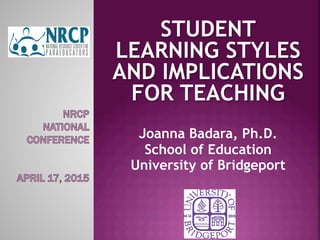
Students Learning Styles and Implications for Teaching
- 1. STUDENT LEARNING STYLES AND IMPLICATIONS FOR TEACHING Joanna Badara, Ph.D. School of Education University of Bridgeport
- 2. ž Learning styles; ¡ Science classroom; ž Diversity in the classroom; ž Implications for paraeducators. ž Instructional support: ¡ one-on-one tutoring, ¡ assistance with classroom management, ¡ instructional assistance in a computer laboratory, library, media center, ¡ conduct parental involvement activities, ¡ act as a translator.
- 5. ž Proposed by Howard Gardner in his 1983 book Frames of Mind: The Theory of Multiple Intelligences. ž Intelligence exists in multiple forms: ¡ Verbal-linguistic ¡ Logical-mathematical ¡ Intrapersonal (insight) ¡ Interpersonal (social) ¡ Musical-rhythmic ¡ Kinesthetic ¡ Visual-spatial ž All present in varying degrees in an individual
- 6. brain" would be oversimplifying the theory and the brain's functionality. Intelligence Description Linguistic An ability to analyze information and create products involving oral and written language, such as speeches, books, and memos. Logical- Mathematical An ability to develop equations and proofs, make calculations, and solve abstract problems. Spatial An ability to recognize and manipulate large-scale and fine-grained spatial images. Musical An ability to produce, remember, and make meaning of different patterns of sound. Naturalist An ability to identify and distinguish among different types of plants, animals, and weather formations that are found in the natural world. Bodily- Kinesthetic An ability to use one's own body to create products or solve problems. Interpersonal An ability to recognize and understand other people's moods, desires, motivations, and intentions. Intrapersonal An ability to recognize and understand one's own moods, desires, motivations, and intentions. (Table from Davis, Christodoulou, Seider & Gardner, 2011) Traditional teaching is unilateral: verbal-linguistic, logical-mathematical, intrapersonal
- 7. ž Characteristic cognitive, affective, and psychological behaviors that serve as stable indicators of how learners perceive, interact with, and respond to the learning environment ž Do not encompass the ability to learn ž Correlate with preferred career environment, gender, ethnicity, and parental SES
- 8. ž To make teaching and learning a dialogue
- 9. ž To respond to a more diverse student body ž To communicate our message ¡ In a typical 50-min lecture, students retain 70% of what is conveyed in the first 10 min., and only 20% from the last 10 min. ž To make teaching more rewarding ž To ensure the future of our disciplines
- 10. The Myers-Briggs Type Indicator (Personality-based)
- 11. ž Preferences patterns of faculty and students Orientation to Life Perception
- 12. Learning styles and the learning cycle based on Kolb’s model
- 13. ž Sample activities and role of faculty for each Kolb learning style
- 14. ž Felder-Silverman learning styles dimensions in science ž Soloman’s Inventory of Learning Styles
- 15. ž Beginning students tend to be active (processing), sensing (perception), verbal (input), and sequential (understanding); ž Advanced students tend to be more reflective (processing), visual (input), and global (understanding), than beginning students ž Faculty tend to be more reflective (processing), intuitive (perception), and inductive (organization), than students
- 16. Several major implications are apparent ž Most of your students learn differently than you do. ž Each of your students learns differently from your other students. ž No one teaching method will effectively reach all of your students. ž You cannot address all of your students' learning styles all of the time. Use different teaching approaches all of the time!
- 17. ž Balanced approach in teaching to allow for diverse learning styles ž Provide a context for learned concepts – global learners; ž Include theory and models along with demonstrations/ examples (intuitive & sensing learners); ž Use both visual and verbal info; ž Use numerical/algebraic examples along with abstract concepts (inductive & deductive learners); ž Provide time for both student active participation and reflection on the material (active & reflective learners)
- 18. ž Respect diverse talents and ways of learning ž Engage students in activities ž Encourage cooperation among students ž Encourage student-faculty contact ž Give prompt feedback ž Emphasize time on task ž Communicate high expectations ž Principles for Good Practice in Post-Secondary Education Chickering, A. W., & Gamson, Z. F. (1987). AAHE Bulletin, 39(7), 3-7
- 19. “No matter how you try to make instruction better for someone, you will make it worse for someone else.” Richard Snow, Educational Psychologist (1989)
- 20. ž Physical, mental, social, emotional differences ž Cultural diversity ž Students at risk ž Gifted and talented students
- 21. Diversity Solutions ž Socio-economic status ž Different cultural values ž Different language ž Gender differences ž Topics that relate to students’ background ž Community resources ž Role models ž Regular contact with parents ž Overcome language barriers
- 22. ž Social, emotional, or physical deprivation ž Inclusion ž Mild mental disabilities ¡ Need structure, direct instruction, one task at a time ž Vision/hearing impairments ¡ Learning through other senses, specific classroom location ž Special social needs ¡ Hands-on instruction, peer tutoring
- 23. ¡ Structured activities within students’ capabilities ¡ Involvement in all school activities ¡ Cooperative learning in heterologous groups ¡ Sincere praise ¡ Communication with parents ¡ Opportunities for sharing
- 24. ž Outstanding capabilities ¡ Above average abilities ¡ Task commitment ¡ Creativity ž Evaluation of the ‘Intelligence Quotient’ and the ‘Interest Quotient’
- 25. ž Allow freedom of topic ž Model construction ž Make contracts with self – independence and structure ž Emphasize process skills ž Community involvement
